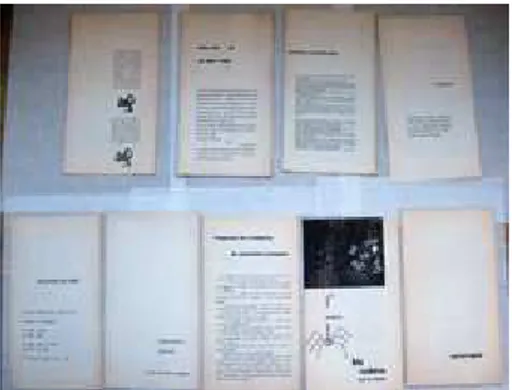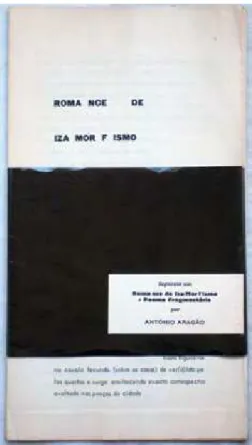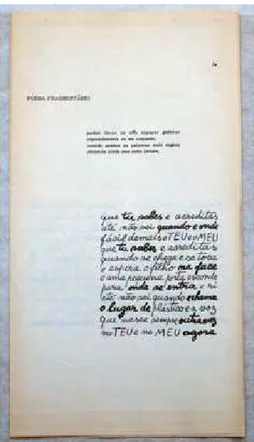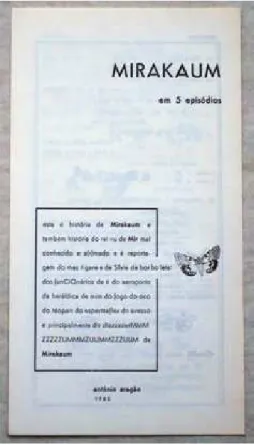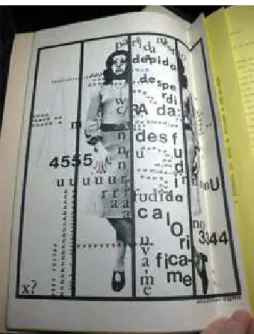TEMA DE CIBERTEXTUALIDADES 07
estudos sobre António ArAgão
simplesmente dobrAr e
desdobrAr» [“to reAd”
the poem is simply to
fold And unfold]. Artist’s
books by António ArAgão
Catarina Figueiredo Cardoso
1RESUMO: Este artigo é um curto catalogue raisonné dos livros de artista de António Aragão. Trata exclu-sivamente dos livros de Aragão que classifico como livros de artista: livros concebidos como objectos artísticos, cujo conteúdo é consubstancial ao formato e que colocam em primeiro plano o livro como meio artístico. Analiso apenas os livros de que Aragão é o único autor, e os dois números da revista Poesia Experimental.
PALAVRAS-CHAVE: Livro de artista; poesia experimental.
ABSTRACT: This essay is a short catalogue raisonné of artist’s books by António Aragão. It deals exclusively with those of Aragão’s books I classify as artist’s books: books conceived as art objects, the content being consubstantial to the format, in ways that foreground the book as a medium. The analysis is only on the books authored by Aragão alone, and Poesia Experimental 1 and 2.
KEyWORDS: Artist’s books; Experimental poetry.
"Concrete poets have engaged with books as a conceptual space (…). not every concrete poet is a book artist, and not every concrete work is an artist’s book, but there are works which demons-trate the ways in which concrete poets have been able to extend the parameters of what a book does as a verbal field in a manner which also extends the possibility of the ways an artist’s book can function as a poetic text". (Drucker 2004: 10).
1. ARTIST’S BOOkS By AN
EXPERIMENTAL POET
Not all books by experimental poets are artist’s books, and some experimental poets, like Salette Tavares, didn’t make any. But other experimental poets did make artist’s books, as is the case with António Aragão.
This essay focuses on some of Aragão’s artist’s books. It starts with his participation in Poesia Experimental, where he acted also as an editor. This is a natural choice: Poesia Experimental is an artists’ magazine that gathered the experimen-tal poets of the first generation (Sousa & Ribei-ro 2004: 42); by this I mean the poets active in Portugal during the 1960s and 1970s. And it was from the name of the magazine that the group took its self-designation as experimental poets and their practice as experimental poetry (Torres 2005; Sousa & Ribeiro 2004: 19).
It is also natural in another sense: Aragão was one of the editors of the two issues of Poesia Experimental, and the peculiar organization of these collective works as artist’s books may be due to him. Aragão is one of the participants that uses his booklets in a consistent way as autono-mous little books, and he consistently used the book format in his later production.
I will treat Aragão’s artist’s books from the point of view of their materiality, that is, I will concen-trate on the physical and technical aspects of the books as they were put on paper, because the literary aspects of experimental poetry are well studied already.
I will try to show that, both in Poesia Experimen-tal and in Aragão’s other artist’s books, poems and images are not just made for the page. They are made for the book format.
As for their contemporaries and fellow concrete poets all over the world, Portuguese experimental poets’ books “are not just books, not only works of art, but means to intervene in the social debate, instruments of ideological and political struggle” (Moeglin-Delcroix 2012: 135-136). This political aspect of their practice is vehemently vindicated by the Portuguese experimental poets (Hather-ly & Melo e Castro 1981: 169-176; Melo e Castro 1995: 207; Reis 2004) and is clearly present in their
first publication, Poesia Experimental 1.
Poesia Experimental 1 is more political than Poe-sia Experimental 2. There are no references to persecutions by the political Police to the au-thors or organizers, before and after the publi-cation of Poesia Experimental 1. And there is no notice, either, of the seizure by the political Po-lice of any of the issues, nor of a prohibition of publication by the bureau of the censorship. But the truth is that the political situation and the protests against it worsened from 1964 to 1966, namely the opposition to the colonial wars and the students’ demonstrations. This lesser politi-cization of Poesia Experimental 2 maybe is a sign of self-censorship, a strategy often adopted by writers and journalists under dictatorships to continue working.
2.
Poesia exPerimental
1 AND 2
Poesia Experimental is an artist’s magazine. I classify as an artists’ magazine a periodical2 pub-lication that reflects on the place of art in the contemporary society that questions the role of the artist/public relation, and shows the will of artists to take a position on society at large. Artists’ magazines integrate the larger group of artists’ publications, where we also find artist’s books. The internal organization of both issues of Poesia Experimental in booklets, and the cir-cumstance that some of these booklets, individ-ually considered, can also be classified as artist’s books, lead to the qualification of Poesia Experi-mental as artist’s books.
In fact, what is important in Poesia Experimental is not the mode of publication (periodical and collective, with the periodical aspect confined to two issues) but the material operations that organize the bibliographic syntax of the book-lets, at the same time redefining their textual graphicality.
Most booklets in Poesia Experimental qualify as artist’s books: books entirely conceived as art objects, the content being consubstantial to the format, in ways that foreground the book as a medium. This definition presupposes that the book is a medium, in the sense of a specific artistic means of expression as determined by the creative methods involved and the materials used and in the feedbacks among formats, visual structures and other signifying layers.
In both issues of Poesia Experimental most au-thors seem to have conceived and designed their booklets as a “total work of art”, turning the materials, the sequencing of pages, the layout of individual pages, the binding and fol-ding, and the entirety of the booklet – as much as the experiments with language itself - as an element of the work. These self-conscious
ope-2 Or that is presented with the aim of being a periodical; many artists’ magazines in practice only have one issue.
rations on the book format are an integral part of the experimentalists awareness of message of the medium. When typographical structures of Poesia Experimental 1 and Poesia Experimental 2 are closely analyzed in relation to their linguis-tic and poelinguis-tic structures, it becomes clear that the form of the book is also part of their poetical experiment.
Figure 1. Poesia Experimental 1. The booklets.
Poesia Experimental 1 is a collection of concrete poems, most of them rather classic in their ty-pographic composition. It is organized in loose folios: each folio is folded in three parts in a z--fold, and this folding makes each folio look like a booklet.
This disintegration of the signatures and their printing and folding in discrete units is akin to the combinatory and permutational logic of linguistic operations of concrete poetry. This combinatory logic is taken further in Poesia Expe-rimental 2 where the booklets are not numbered and the possible order is given by the table of contents that lists the authors in the alphabetical order of the first name.
On the contrary, the pages of the folios in Poe-sia Experimental 1 are numbered in sequence. Most folios are written in the vertical, the first page being a recto (an odd page) and its verso an even page. When closed, the booklet shows the page with the title (in the following exam-ples, “poesia encontrada” and “atravessado pela cidade”) as title page.
In the side of the folio that bears the first or title page, text is organized in a single page, and the two other pages of that side can be organized in a double spread, or in two single pages.
Figure 2. Poesia Experimental 1. From left to right: pages 41-42 and 37. Example of organization of the text in two single pages and the title page.
Figure 3. Poesia Experimental 1. From left to right: pages 53-54 and 49. Example of organization of the text in a double-page setting and the title page.
António Aragão has two sets of contributions to Poesia Experimental 1. One is “Separata um”, the other is “Poesia encontrada”.
Figure 4.Poesia Experimental 1. The five booklets of ‘Separata um’ (pages 7-36).
Figure 5. Poesia Experimental 1. The cover page of “Separata um” and the band.
This is a fake offprint: the pages are numbered in the sequence of the previous and next book-lets, integrated in the sequence of pages. It is true that it forms an autonomous unit. But that is what happens with all the other works in Poesia Experimental 1. The fakeness is reinforced by the fact that the band is too tight to contain the five booklets. Probably the original delivery of the magazine was made with the band just on the
first booklet, leaving the remaining parts of the “separata” clearly embedded on the sequence of the pages.
The text is a typical concrete poem with the cha-racteristic blanks in the middle of phrases and strange ending of paragraphs. It goes on con-tinuously from page 7 to page 32, in the usual sequence of pages. The sequence of pages, however, is usual only apparently. Because each
booklet is folded in three parts, it has 6 pages. And it is a z-fold. Therefore, the verso of page 7 is page 8, which makes a double spread with page 9. The verso of page 9 is page 12, but the text continues in page 10. Page 10 is a verso; its recto is page 11, and page 11 forms a double spread with page 12.
11 12 7
Title page
8 9 10
The following booklet starts at page 13, and so on until page 32, in the fifth booklet.
Figure 6. Poesia Experimental 1. pages 32-34.
Figure 7. Poesia Experimental 1.page 34.
Visually, the fragmentary poem is completely different from the “novel”. It is handwritten and the text blocks occupy only the bottom half of the pages. After the title, there are instructions to the reader: “podem ler-se os três espaços
grá-ficos separadamente ou em conjunto. usando apenas as palavras mais negras obtem-se ainda uma outra Leitura” [the three graphic spaces can be read separately or together. using only the words in bold there is a new Reading].
However, “Poema fragmentário” cannot be visually apprehended in a single view. The poem occupies three pages, the three graphic spaces mentioned in the instructions. The first page of the poem is the back page of the booklet, page 34. Its verso is page 35. Only pages 35 and 36 make a spread, the-refore only they can be read together in the sense that only they can be seen simultaneously.
Figure 8.Poesia Experimental 1. pages 35-36.
In the following folio, pages 37-42, titled “Poesia encontrada” [found poetry], António Aragão ex-plains how to write and how to read found poetry.
The two examples he presents “vieram dos jor-nais” [came from the newspapers]. The author continues: «a maleabilidade da expressão per-mite várias leituras, isto é, faz com que apareçam diversos poemas dentro do mesmo poema ou um poema ligado a outro ou uma outra poe-sia conseguida por diferente articulação» [the malleability of expression allows for multiple readings, i.e., makes several poems appear wi-thin the same poem or a poem connected to another or other poetry achieved by a different articulation]. The author himself offers a reading, a reading he found «mais afim com uma dada nossa ocasião» [more akin to a given occasion of ours] (see also Portela 2013: 150). And in the next page, page 38, Aragão transliterates the poems reproduced in pages 39 and 41.
Figure 10.Poesia Experimental 1. pages 38-39.
These reproductions are hard to read, undoub-tedly due to the poor quality of the paper, and the lack of finesse of the typographic work rela-ted to the craftwork aspect at the origin of these magazines (Torres 2012: 12). The scale of the re-productions certainly adds to this difficulty; the collages of pages 39 and 41 occupy a print space of 245x145mm. Even though we can guess the originals were bigger, they were made with cut--outs from newspapers, probably also of poor quality. And the obliteration of words and let-ters in the original collages was made with ink, certainly absorbed by the porous paper of the cut-outs and therefore easily spilling over the
neighbouring words and phrases that were sup-posed to be spared. Even so, at least in the copy I am using, the poem of page 41 is rather clean and easy to read, whereas the poem of page 39 is more blurred. This can be due to printing itself: page 39 and page 41 are in opposite sides of the same paper sheet, so necessarily they were prin-ted by different cylinders.
Figure 12. Poesia Experimental 1. page 41.
The political preoccupations of the experimen-tal poets are claimed by themselves, both in this more immediate way, in the very elements of the verbal discourse, and in the attitude that experi-mental poetry implied: to affront the established literary critics that praised exclusively the ro-mantic and lyric traditions of Portuguese poetry (Torres 2012: 9; Hatherly & Melo e Castro 1981: 169-176; Sousa & Ribeiro 2004: 29-30, 43-44).
Figure 13.Poesia Experimental 1. pages 38-40.
In this folio an incongruity persists: the found po-ems by Aragão are in pages 39 and 41. Between them (side by side with page 39 if we fully open the folio and in any case in the recto of page 41; cf.
fig. 13) there is page 40. In the bottom of page 40 is a cut-out, the fragment of a collage that func-tions as a transition, a binding element between the two poems. There are a few words but none is complete and some fragments may belong to several Portuguese words like “mico” or “ida” or “sauda”. When the six-page folded folio is closed, this page can be assumed as the back page. Page 37, with its disposition of beginning of chapter and the title, is the title page. Again, in the layout of this folio, we see that Aragão himself, or the undisclosed person3 who made the graphic de-sign of Poesia Experimental 1, wanted to present each folio, or each collection of related folios, as small books and not as sheets of paper to be seen and exhibited as pictures (cf. Moeglin-Delcroix 2012: 87). The Portuguese experimental poets did made books as books, although never mak-ing an explicit reference to this intention.
Poesia Experimental 2 was published in May 1966. The imprint is the same as for Poesia Experi-mental 1, Cadernos de Hoje, at the same address (Travessa do Fala-Só, 15, 2º esq. b in Lisbon) but it was composed and printed at the School of Arts and Crafts at Funchal, in Madeira Island, certainly under the influence of António Aragão and
berto Helder, who were both born in Funchal, and where at least Aragão was probably living then. This second anthology or “caderno anto-lógico” was again organized by Aragão and Hel-der, joined by E. M. de Melo e Castro, apparently due to the growing distance of Helder from the group’s activities (cf. Torres 2012: 11). The cover was once again made by Ilídio Ribeiro with a text by Lewis Carroll at the back cover. The cover of Poesia Experimental 2 is in fact an envelope, who-se sides are stapled with big staples. There is also a ‘separata’ or offprint by the musician Jorge Pei-xinho titled “Music and Notation”.
The quality of printing and of the paper is higher than in Poesia Experimental 1, and works that are difficult to reproduce, like Ana Hatherly’s and Sa-lette Tavares’s, are mostly clean and with good contrasts.
Figure 14. Poesia Experimental 2. The booklets.
Like Poesia Experimental 1, Poesia Experimental 2 is organized in booklets, except for the offprint. In a way, the autonomy of each booklet is bi-gger than in Poesia Experimental 1: pages are not numbered, nor sequentially nor in each booklet (with the exception, again, of the offprint).
Also like in Poesia Experimental 1, the booklets are folded in three parts. But the folding, with one exception, is different: it is a tri-fold, while the booklets in Poesia Experimental 1 are z-folds.
The exception in Poesia Experimental 2 is Herber-to Helder, whose booklet is a z-fold.
Figure 14-A. the tri-fold.
Most booklets are individual and are used by their authors as a significant conceptual space. The exceptions are the two booklets assigned to some of the foreign authors who participa-te in Poesia Experimental 2: the space and page orientation are allocated according to necessity, although (we guess) respecting the organization and spatialization of words and letters the au-thors sent to the organizers.
The tri-fold format and the lack of numbering of the pages make the use of the inner face of the paper sheet as a single space easier and simpler. The outer face is still used by the authors as co-ver or title page, but now the back coco-ver or back page is the centre panel.
Figure 15. Poesia Experimental 2. Booklet by António Aragão. Title page.
The title page displays the title, “Mirakaum em 5 episódios” [Mirakaum in 5 episodes], the name of the author and the year (1965, not the same year of publishing4), and a presentation of the content. The presentation is written in the rect-angle and the butterfly is there precisely to il-lustrate the word “borboleta/butterfly”. This is a presentation of the following text: a mixture of typeset and handwritten text, drawings by the author and a bad reproduction of a photograph marking the end of the text and of the booklet.
4 Apparently this text was released as an autonomous publica-tion in 1965, printed at the Salesian School of Arts and Crafts at Funchal, Madeira Island; cf. Torres & portela 2012, p. 32.
Figure 16.Poesia Experimental 2. Booklet by António Aragão. Second to fourth pages.
The text is arranged in five panels, one per page. The panel arrangement is reinforced by a contour line that allows a different header in every page and footnotes in the third and fourth pages.
Figure 17. Poesia Experimental 2. Booklet by António Aragão. Fifth and sixth pages and title page.
The reading sequence is marked by permuta-tions of the headers: SPINTRAMA-SPINTRANSE--CICLAMANDO-CICLARDENDO-PENSEANDO; they accompany the sequence of the pages, from the verso of the title page to the sixth or back page, the counterpoint to the title page when the booklet is closed.
3. ELECTROGRAPHy
with individual and collective exhibitions of vi-sual poetry and electrography, performances and sale of Portuguese and international publi-cations on these areas5.
The first collection of electrographies Aragão reunited is Metanemas (s. l., 1981). It is composed by 27 loose sheets in a jacket, printed in offset. They are a critic to the violence and superficiality of the consumer society, showing images taken from foreign magazines. In fact, there is no clear connexion to the Portuguese reality of the late 1970s to early 1980s and the entire look is reso-lutely international.
Figure 18. Metanemas. http://po-ex.net/ taxonomia/materialidades/planograficas/ antonio-aragao-metanemas
They are not exactly the traditional electrogra-phies, because they don’t show the distortions resulting from dragging the paper on the surfa-ce of the scan. But the disposition of the images in a grid, the misalignments and juxtapositions,
5 I thank josé Oliveira for this information.
the quality of the images, are indications of the use of a Xerox machine for the graphic design.
In Toma Toma Toma Tomo 7 (s.l., s.d. but 1980 or before), whose authors are Aragão and Adelina Novais, Alberto Pimenta, Alda Clemente, Ana Ha-therly and Vitorino de Sousa, Aragão publishes two other images of this series. They are less violent but the critic to the consumer society is more explicit.
Figure 20.Toma Toma Toma.
In 1990, Aragão publishes three volumes of elec-trographies, Electrografia (Lisbon: Vala Comum, 1990). Each volume is organized as a separate book, with a subtitle and a complete sequence. They reunite previous work, but these images were reworked to integrate the book and form a coherent discourse.
Electrografia 1 is subtitled “O Elogio da Loura de Ergasmo nu Atlânticu” and dated 1984. The con-tent is a dialogue between an aged mother and her 7 or 8 year-old son; if the boy didn’t address her as mother we would say she is his grand-mother. The distorted images of mother and son walking on the street, the mother carrying a shopping bag, are punctuated by the image of three policemen with sticks beating a helpless crouching man. In most images the boy has a hand on his head, in the typical gesture of a child massaging the aching place where he took a slap. The boy keeps making difficult questions about a minister, God and politics. The mother tries to make him stop without success and gives some conformist answers. The whole book has a vio-lent tone.
Figure 21.Electrografia 1: “O Elogio da Loura de Ergasmo nu Atlânticu”. http://po-ex.net/ taxonomia/materialidades/planograficas/ antonio-aragao-electrografia-1
Figure 22.Electrografia 2: “Merdade my Son”. http://po-ex.net/taxonomia/materialidades/ planograficas/antonio-aragao-electrografias
Electrografia 3 is subtitled “Céu ou Cara Dente por Dente” and dated 1987. It shows an athlete running, a contented man apparently watching the race because he carries binoculars hanging from his neck, and an old woman also laughing and making the victory sign with her fingers. The runner and the man are accompanied with phra-ses with a sexual and eschatological content that may also have a political subtext. The woman has phrases that are apparently more innocent but that subliminally also have a sexual content.
Figure23. Electrografia 3: “Céu ou Cara Dente por Dente”. http://po-ex.net/taxonomia/materialidades/ planograficas/antonio-aragao-electrografias
5. OTHER BOOkS AND SO
Figure 25.Lixo. Cover.
Figure 26.Lixo. Back-cover.
I left to the end one of the first books by An-tónio Aragão, Mais Exactamente P(r)o(bl)emas (Funchal: the author, 1968). In its appearance, it is a rather classic book of poetry, with a sim-ple pagination and evenly distributed stanzas. But it is punctuated by some curious elements: three stripes of colour paper with wordplays and a strong graphic component, identified by the author as “istórias” [stories]. There are also other elements common in Aragão’s work: official for-ms from the municipality of Funchal with cance-lations and thus their meaning diverted, found poems made with newspaper cut-outs, a text mixing photos and handwriting.
Figure 24. Os Bancos Antes da Nacionalização. http://po-ex.net/taxonomia/materialidades/ planograficas/antonio-aragao-os-bancos
Politics is the main subject of a publication with a regional flavour: Lixo, mimicking a newspaper or a current magazine of actualities, dedicated to a regional general director for culture whom Aragão accuses of being in Lisbon, with her costs paid by the regional government, to make a use-less report on the regional cultural politics that she will continue to head. This publication has no date, no reference to author or publisher, but is a clear Aragão work6, with his distinctive elec-trographies.
Figure 28.Poema Azul e Branco. http://www.po-ex. net/taxonomia/materialidades/tridimensionais/ antonio-aragao-poema-azul-e-branco
Figure 29. Poema Vermelho e Branco. http://www. po-ex.net/taxonomia/materialidades/tridimensionais/ antonio-aragao-poema-vermelho-e-branco Figure 27. Mais Exactamente P(r)o(bl)emas. http://
po-ex.net/taxonomia/materialidades/planograficas/ antonio-aragao-mais-exactamente-problemas
www.po-ex.net/evaluation/PDF/reis_estado. pdf>. Consultado em 3092014.
SOUSA, C. M. & E. RIBEIRO, orgs. (2004). Antolo-gia da Poesia Experimental Portuguesa: Anos 60-Anos 80. Coimbra, Angelus Novus.
TORRES, R. & M. PORTELA (2012). “A Bibliogra-phy of Portuguese Experimental Poetry”. Journal of Artists’ Books, 32. Columbia College Chicago Center for Book & Paper Arts, p. 32-35.
TORRES, R. (2005). “Apresentação da Poesia Experimental Portuguesa”. CD-ROM da PO.EX. <http://www.po-ex.net/evaluation/PDF/torres_ breve.pdf>. Consultado em 3092014.
TORRES, R. (2012). “Visuality and Material Ex-pressiveness in Portuguese Experimental Poet-ry”. Journal of Artists’ Books, 32. Columbia College Chicago Center for Book & Paper Arts, p. 9-20.
6. A SHORT
catalogUe raisonné
This essay is a short catalogue raisonné of artist’s books by António Aragão. It doesn’t deal with all his books, not even with all his books of ex-perimental poetry. My intention was exclusive-ly to draw attention to those of Aragão’s books I classify as artist’s books: books conceived as art objects, the content being consubstantial to the format, in ways that foreground the book as a medium. I concentrated my analysis only in the books authored by Aragão alone, leaving aside collective works like Operação 1, Joyceana or Filigrama, just to name a few. The exception is not an exception: Poesia Experimental is com-posed by individual booklets, each treated au-tonomously, and therefore I consider Aragão’s contribution to it as single authored books. And in any case, Poesia Experimental is far too important to be left outside any bibliography of its participants.
REfERENCES
Arquivo Digital da PO.EX, coord. Rui Torres
<http://po-ex.net/>.
MELO E CASTRO, E. M. de (1995). Voos da Fénix Crítica. Lisbon, Edições Cosmos.
DRUCKER, J. (2004). The Century of Artist’s Books. New York, Granary Books.
HATHERLy, A. & E. M. de MELO E CASTRO (1981). Po-Ex: Textos Teóricos e Documentos da Poesia Ex-perimental Portuguesa. Lisbon, Moraes.
MOEGLIN-DELCROIx, A. (2012). Esthétique du livre d’artiste: Une introduction à l’art contemporain. 2nd ed. Marseilles/Paris, Le mot et le reste/BNF.
PORTELA, M. (2013), Scripting Reading Motions: The Codex and the Computer as Reflexive Ma-chines. Cambridge, Mass: MIT Press.
